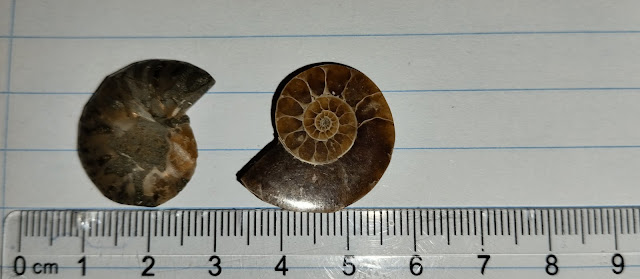AGATE AMMONITES: HOW THEY CAN REVEAL MORE HISTORY THAN OTHER ONES
AGATE AMMONITES: HOW THEY CAN REVEAL MORE HISTORY THAN OTHER ONES
An agate ammonite (sliced and polished) I bought
As most of you may know, there are many modes of preservation, some of which are petrification (when the body gets replaced by rocks and minerals found in the sediment ), phosphorization (when the body gets replaced by phosphorus that is found in the sediment) and opalization. There are also many species of ammonites which can be found in all continets. So, why am I telling you this? Well, the reason is simple: I am going to prove to you that most agatized ammonoids are better than other ammonoids because of their preservation. But first, let's look at...
THE PRESERVATION MODES
Fossils get preserved in various ways based on what kind of sediment they're covered by (in the case of marine life). The most ammonites that I've talked about in this blog are petrified, which is a rather simple to understand process: An ammonite dies and its body gets quickly covered by sediment; then, after many years, its shell decomposes, leaving a hole in the sediment which has the original shell's shape. This hole will later be filled by minerals, which along with the now petrified sediment (which in our case is limestone) will be exposed after millions of years as a fossil. This is the case of the AMFC ammonite fossils. Unfortunately, in this mode of preservation the only thing we can see is the outer shape and structure of the shell and not anything else. However, a similar, yet more interesting mode is permineralization, which occurs just like petrification but instead of the more sedimentary minerals the outer mould of the shell is replaced with quartz, agate etc. In this mode, the fossil is fossilized in its full potential, with the cambers being visible if it is broken/sliced, parts of the original shell being preserved more occational than in petrification and more.
WHAT DOES THE AGATIZED SPLIT FOSSIL REVEAL (AND WHAT DOES A PETRIFIED ONE DO?)
As I mentioned above, agatized ammonites feature a lot more than petrified ones because of their method of fossilization. In the below diagram you can see what is revealed through the agatized ammonite I bought.
In the image above, you can clearly tell the original shell and the agate parts of the body (which are the parts you can see through) from the external mould (which are the parts you can't see through). The sutures are also highlighted, making the ammonitic pattern more visible.
External Mould (1a), Original Shell (2a), Possible Phylloceratic Pattern (3a).
Siphuncle (1b), Septa (2b), Umbiculus (3b)
Of course, the fossil reveals far more than what is shown above (Including the phragmocone, the living chamber, the ribs etc) but I couldn't fit all that in one image. We can see that in this fossil the insides of the chambers have also been filled with agate, giving them this beautiful look. A big part of the outer shell is actually petrified, with sedimentary rock being visible (1a). I did an experiment and put the specimen above light, resulting in this beautiful picture.
Comparison
We will now compare this specimen with one of my petrified specimens, specifically AMFC-0009.
Living chamber(1) and Septa(2)
Because of its preservation mode, AMFC-0009 has indeed very distorted features, with a Phragmocone which one can barely make out, a distorted and broken umbiculus, an unclear living chamber and a generally distorted outline. The only thing which you can for sure make out of this is the Septa, which are unlike the other features crystal clear in specific areas.
There are many more fossilization modes in which ammonites have gone through, however, in my opinion, none compare to permineralization. Many of the fossils which keep the best detail regarding what they looked like back in the day are those preserved in Iron Pyrite, Quartz and Agate. So, I personally believe that if you want to study ammonite anatomy you should look at these fossils.
Thank You For Reading!
Hey, you can now officially visit one of my old sites in the link found on the side bar!
You can check my TikTok which is @aggelos_mantos
Bibliography and Sources
Wikipedia
DK Handbooks- Fossils
-Aggelos Mantos





Comments
Post a Comment